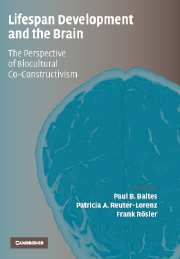Book contents
- Frontmatter
- Contents
- List of Contributors
- Preface and Acknowledgments
- Lifespan Development and the Brain
- PART ONE SETTING THE STAGE ACROSS THE AGES OF THE LIFESPAN
- PART TWO NEURONAL PLASTICITY AND BIOCULTURAL CO-CONSTRUCTION: MICROSTRUCTURE MEETS THE EXPERIENTIAL ENVIRONMENT
- PART THREE NEURONAL PLASTICITY AND BIOCULTURAL CO-CONSTRUCTION: ATYPICAL BRAIN ARCHITECTURES
- PART FOUR BIOCULTURAL CO-CONSTRUCTION: SPECIFIC FUNCTIONS AND DOMAINS
- PART FIVE PLASTICITY AND BIOCULTURAL CO-CONSTRUCTION IN LATER LIFE
- PART SIX BIOCULTURAL CO-CONSTRUCTION: FROM MICRO- TO MACROENVIRONMENTS IN LARGER CULTURAL CONTEXTS
- 13 Characteristics of Illiterate and Literate Cognitive Processing: Implications of Brain–Behavior Co-Constructivism
- 14 The Influence of Work and Occupation on Brain Development
- 15 The Influence of Organized Violence and Terror on Brain and Mind: A Co-Constructive Perspective
- 16 Co-Constructing Human Engineering Technologies in Old Age: Lifespan Psychology as a Conceptual Foundation
- PART SEVEN EPILOGUE
- Author Index
- Subject Index
- References
16 - Co-Constructing Human Engineering Technologies in Old Age: Lifespan Psychology as a Conceptual Foundation
Published online by Cambridge University Press: 17 July 2009
- Frontmatter
- Contents
- List of Contributors
- Preface and Acknowledgments
- Lifespan Development and the Brain
- PART ONE SETTING THE STAGE ACROSS THE AGES OF THE LIFESPAN
- PART TWO NEURONAL PLASTICITY AND BIOCULTURAL CO-CONSTRUCTION: MICROSTRUCTURE MEETS THE EXPERIENTIAL ENVIRONMENT
- PART THREE NEURONAL PLASTICITY AND BIOCULTURAL CO-CONSTRUCTION: ATYPICAL BRAIN ARCHITECTURES
- PART FOUR BIOCULTURAL CO-CONSTRUCTION: SPECIFIC FUNCTIONS AND DOMAINS
- PART FIVE PLASTICITY AND BIOCULTURAL CO-CONSTRUCTION IN LATER LIFE
- PART SIX BIOCULTURAL CO-CONSTRUCTION: FROM MICRO- TO MACROENVIRONMENTS IN LARGER CULTURAL CONTEXTS
- 13 Characteristics of Illiterate and Literate Cognitive Processing: Implications of Brain–Behavior Co-Constructivism
- 14 The Influence of Work and Occupation on Brain Development
- 15 The Influence of Organized Violence and Terror on Brain and Mind: A Co-Constructive Perspective
- 16 Co-Constructing Human Engineering Technologies in Old Age: Lifespan Psychology as a Conceptual Foundation
- PART SEVEN EPILOGUE
- Author Index
- Subject Index
- References
Summary
ABSTRACT
Human engineering technologies highlight the bioculturally co-constructed nature of human ontogeny. Based on concepts from lifespan psychology, we propose three criteria for evaluating human engineering technologies in old age: marginal gain for the individual, person specificity and adaptability, and conjoint consideration of distal and proximal frames of evaluation. Informed by research on expert memory performance and negative adult age differences in sensory, motor, and cognitive functioning, we propose strategies for incorporating these criteria into the design of human engineering technologies. We expect that intelligent human engineering technologies will alter the aging of future generations by reducing cognitive resource demands through personalized external cuing structures.
INTRODUCTION
Recent years have witnessed increasing efforts at improving and expanding human engineering technologies for diverse segments of the adult and elderly population (Charness & Schaie, 2003; Kautz, Etzioni, Fox, & Weld, 2004; LoPresti, Mihailidis, & Kirsch, 2004). In this chapter, we discuss the potential of human engineering technologies to counteract negative adult age changes in sensory/sensorimotor and cognitive domains. We devote special attention to intelligent human engineering technology (IHET), that is, to assistive devices and environments apt to learn from, control, supervise, and regulate behavior (Kautz et al., 2004; Patterson, Liao, Fox, & Kautz, 2003).
Human behavior enmeshed in assistive technology is not fundamentally different from any other form of human behavior. At the same time, the unprecedented capacity of IHET to adapt to, predict, supervise, assist, and eventually control human behavior sets it apart from less adaptive assistive devices such as canes or reading glasses.
Information
- Type
- Chapter
- Information
- Lifespan Development and the BrainThe Perspective of Biocultural Co-Constructivism, pp. 350 - 376Publisher: Cambridge University PressPrint publication year: 2006
References
Accessibility standard: Unknown
Why this information is here
This section outlines the accessibility features of this content - including support for screen readers, full keyboard navigation and high-contrast display options. This may not be relevant for you.Accessibility Information
- 2
- Cited by
